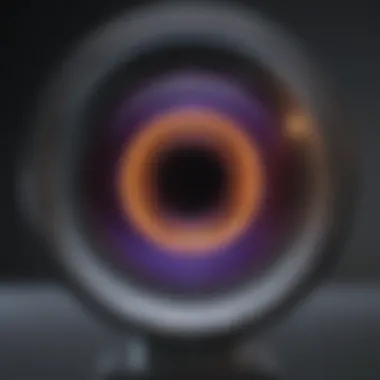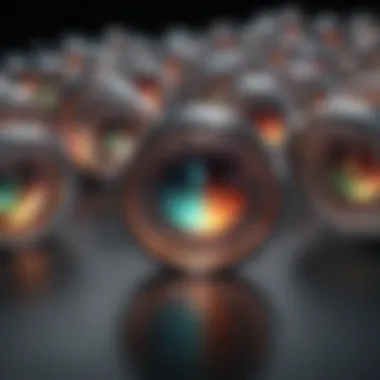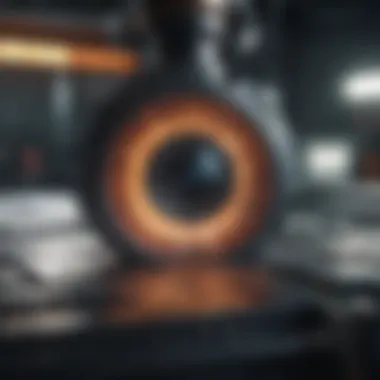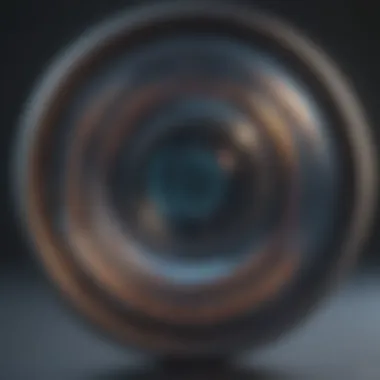Exploring Diffractive Optical Elements in Depth


Intro
Diffractive optical elements (DOEs) have become integral in various optical systems. Their ability to manipulate light makes them suitable for applications in telecommunications and medical imaging. Understanding the principles behind DOEs is essential for professionals in these fields. This article will discuss foundational concepts, types, manufacturing processes, and the advantages and limitations of DOEs. The aim is to provide a clear guide to their impact on modern technology and future directions.
Research Overview
Summary of Key Findings
This research delves into several pivotal aspects of diffractive optical elements. The initial focus is on the fundamental principles of diffractive optics, revealing how these elements interact with light in sophisticated ways. It discusses various kinds of DOEs, such as holographic elements and Fresnel lenses, each serving unique purposes.
Furthermore, the manufacturing processes of DOEs are examined. Different techniques such as photolithography and direct laser writing are instrumental in creating these elements with high precision. The research highlights the wide-ranging applications, from optical communication systems to surgical imaging tools.
Importance of the Research
The relevance of this research lies in its scope and detail. Understanding DOEs not only offers insights into their current use but also elaborates on potential advancements. As optical technologies evolve, the demand for innovative solutions will likely grow. By examining the capabilities and challenges faced by DOEs, this research aims to inform future developments and applications in the field of optics.
Methodology
Study Design
The study employs a comprehensive review of existing literature on diffractive optical elements. It synthesizes findings from various sources to create a cohesive overview. Emphasis is placed on both theoretical foundations and practical implementations of DOEs in different sectors.
Data Collection Techniques
Data for this research was gathered through scholarly articles, technical manuals, and reputable optical technology journals. Key insights were extracted from these sources and organized systematically to facilitate deeper understanding.
"Diffractive optical elements represent a fusion of art and science, making light work in ways once thought impossible."
This article aims to equip students, researchers, and industry professionals with the knowledge to navigate the complexities of diffractive optics.
Prologue to Diffractive Optical Elements
Diffractive optical elements (DOEs) are crucial in the modern optical landscape. Their ability to manipulate light waves offers significant advantages in various fields. These elements range from spatial light modulators to Fresnel lenses. Understanding DOEs is essential for grasping the future of optical systems. They enable advanced functionalities in compact forms, leading to more innovative designs.
Definition and Overview
Diffractive optical elements are designed to control the propagation of light through diffraction. They utilize the wave nature of light to achieve specific manipulations like beam shaping, splitting, or focusing. Unlike traditional lenses, which rely on refraction, DOEs work based on patterns etched or molded onto a surface. This patterning allows for a precise control over light's optical properties, making them suitable for many applications.
In practical terms, DOEs can be viewed as phase shifters that alter the phase of incoming light waves. This manipulation results in desired outputs, such as laser beams being reshaped for uniform intensity distribution or specific angular spread. The design of these elements can be complex, requiring an understanding of optical principles and material science.
Historical Context
The journey of diffractive optical elements began in the mid-20th century. Initially, they were limited by manufacturing techniques and a less comprehensive understanding of light properties. With advancements in optical design and digital manufacturing, their utilization expanded significantly.
Notable developments contributed to the modern use of DOEs. The introduction of computer-generated holography in the 1970s marked a significant turning point. This method allowed for intricate designs that were previously inconceivable. In the following decades, with the advent of laser technologies, the scope of DOEs broadened further, finding roles in telecommunications, sensors, and even consumer electronics.
Today, DOEs are an active area of research. New materials and fabrication technologies continually evolve, leading to innovative applications and functions. As industries seek more compact and efficient optical solutions, the relevance of diffractive optical elements is more important than ever.
Fundamental Principles of Diffractive Optics
The study of diffractive optics is foundational to understanding how diffractive optical elements (DOEs) function in various applications. The fundamental principles provide a framework for manipulating light, which is critical in fields like telecommunications, medical imaging, and consumer electronics. The interaction of light with materials at the wavelength scale, along with the precise control of wavefronts, leads to innovations that change how optical systems are designed and utilized.
Wavefront Manipulation
Wavefront manipulation refers to the ability to modify the phase and amplitude of light waves using DOEs. This manipulation alters the direction in which light propagates, allowing for the creation of complex optical phenomena. DOEs can be designed to produce various wavefront shapes, which can focus or disperse light effectively.


One of the primary advantages of wavefront manipulation is that it enables compact and lightweight optical designs. For example, when designing optical systems for smartphones or cameras, achieving desired focusing effects without relying on bulky lenses is invaluable.
In addition, wavefront manipulation allows for customization in optical applications, ranging from laser beam shaping to image correction. This is especially crucial in applications like high-resolution imaging and optical communication, where precision is essential. By allowing specific control over the light properties, DOEs enhance performance and efficiency, leading to better systems overall.
Diffraction and Interference Effects
Diffraction and interference are phenomena that arise when light encounters obstacles or slits comparable in size to its wavelength. Understanding these effects is essential for the effective use of DOEs because they fundamentally describe how optical elements interact with light.
Diffraction occurs when waves pass through a small aperture or around an edge, causing them to spread out. This spreading can be controlled to enhance or diminish particular light paths. For instance, diffraction gratings, a type of DOE, exploit this principle to separate different wavelengths of light for various applications such as spectroscopy.
Interference is the combined effect of two or more overlapping waves, which can either amplify or reduce light intensity depending on their phase relationship. DOEs can be designed to create specific interference patterns, which are useful in applications like holography.
The importance of these phenomena cannot be overstated as they underpin many optical technologies today.
"Understanding diffraction and interference is crucial for optimizing the design and application of diffractive optical elements."
In summary, the fundamental principles of diffractive optics lay the groundwork for intuitively grasping how light can be controlled and manipulated. With ongoing advancements in these areas, the potential applications of DOEs continue to expand, ushering in new technological possibilities.
Types of Diffractive Optical Elements
Diffractive optical elements, often called DOEs, serve multiple functions within optical systems. Their design and application are as varied as they are innovative. Understanding the types of DOEs is crucial for appreciating their influence on modern optics. Key elements like spatial light modulators, diffractive beam splitters, phase-only diffractive elements, and Fresnel lenses each offer unique advantages and applications. Each type has specific characteristics, which can affect the performance and capabilities of optical systems.
Spatial Light Modulators
Spatial light modulators (SLMs) represent a significant leap in optical technology. They control light on a pixel-by-pixel basis through varying amplitude and phase settings. This capability is essential for applications in holography and adaptive optics. SLMs enable real-time manipulation of wavefronts, making them invaluable in projects where precision is vital.
These devices often use liquid crystal technologies or micro-electromechanical systems (MEMS) to control the light. The flexibility of SLMs allows for extensive customization, adapting to different light patterns and requirements. As a result, they have found uses in areas like interactive displays, laser material processing, and scientific imaging.
Diffractive Beam Splitters
Diffractive beam splitters function by redirecting incoming light into multiple paths. They diffract light instead of reflecting or refracting, making them more compact compared to traditional beam splitters. This feature is especially useful in systems requiring minimal space while maximizing performance.
These beam splitters are designed for precise control of light division ratios and can handle various wavelengths effectively. They are commonly employed in telecommunications and scientific instrumentation. The increasing demand for miniaturized optical devices makes diffractive beam splitters an attractive option for engineers and designers.
Phase-Only Diffractive Elements
Phase-only diffractive elements are designed to manipulate the phase of an incoming light wave without altering its amplitude. This aspect is crucial for applications in optical beam shaping and wavefront deformation. By altering the phase, these devices can create effects such as focusing and beam steering.
These elements are implemented in diverse fields, from optical communication systems to advanced imaging techniques. The design flexibility allows engineers to produce specific diffraction patterns that meet unique requirements. As research progresses, phase-only diffractive elements continue to evolve, promising enhanced performance.
Fresnel Lenses
Fresnel lenses offer a lightweight, compact alternative to traditional lenses while maintaining effective optical performance. These lenses use a series of concentric grooves to focus light, allowing for significant reductions in size and weight. Their design is a breakthrough that has led to their widespread use in various applications, such as projectors, lighthouses, and solar concentrators.
The efficiency of Fresnel lenses is evident in their ability to gather and focus light effectively, making them a preferred choice in scenarios where size and weight are critical factors. Their continued advancement in design and materials is paving the way for new innovations in consumer electronics and optical systems.
"The choice of diffractive optical element can significantly influence both the performance and efficiency of the optical system."
Each type of diffractive optical element presents unique benefits and considerations, making them essential components in modern optical engineering. By understanding these types, the broader implications of DOEs in advancing optical technologies become clear. As these elements continue to evolve, so too will their applications and impact.
Manufacturing Techniques for DOEs
The manufacturing techniques for diffractive optical elements (DOEs) play a pivotal role in ensuring their functionality and precision. High-quality fabrication processes are essential for producing DOEs that meet the stringent demands of various applications, from telecommunications to medical imaging. Each method possesses unique advantages and considerations that influence the performance of the final products. Understanding these techniques helps illuminate the path towards optimal design and deployment of DOEs in advanced optical systems.
Lithographic Methods
Lithographic methods stand as one of the most widely used approaches in DOE production. This process typically involves the application of a photosensitive material on a substrate, which is then exposed to ultraviolet light to create intricate patterns. The key stages include developing, etching and, ultimately, the transfer of the desired diffractive design onto the substrate.


The precision achieved via lithography ensures that the detailed structure of the DOE is accurately reproduced. This method supports various patterns, making it versatile for different optical functions. However, it also demands high-cost infrastructure and expertise, which may limit access for some practitioners.
Laser Ablation Techniques
Laser ablation techniques present another effective approach for creating DOEs. This method uses focused laser beams to remove material from the substrate, creating precise microstructures. The accuracy of laser ablation allows for the development of diverse shapes and complexities, catering to specific application requirements.
A primary advantage of this technique is its flexibility. Different materials can be processed, permitting a range of optical properties. Furthermore, the ability to execute rapid prototyping with laser ablation fosters innovation and customization. However, careful control of parameters like laser intensity and exposure time is crucial to prevent unintended damage to the substrate or adverse optical features.
Replication Technologies
Replication technologies encompass various processes designed to duplicate existing optical features onto new substrates. One of the most common methods is imprint lithography, where a master mold with the desired pattern is pressed into a polymer film, replicating the structure. This technique is particularly valuable for scaling production since it allows the mass production of high-quality DOEs at a lower cost compared to other methods.
This technology offers scalability and efficiency, making it increasingly relevant in high-demand applications. However, maintaining the fidelity of the replicated patterns can pose challenges, particularly when transferring from the master mold to the final product. Therefore, careful attention to detail is critical to ensure that the optical performance remains uncompromised.
In summary, the choice of manufacturing technique greatly influences the functionality and applicability of diffractive optical elements. Mastery of these techniques is essential to advancing DOE technology, making it a crucial area of focus for research and development.
Applications of Diffractive Optical Elements
Diffractive optical elements, often referred to as DOEs, play a pivotal role across diverse sectors in the modern world. Their unique ability to manipulate light enables various functions that significantly enhance performance in several applications. Understanding these applications provides insight into why DOEs are fundamental in advancing optical technology. Below, we will explore various fields where these elements are applied, along with their specific benefits and considerations.
Telecommunications
In the telecommunications sector, DOEs serve a crucial purpose by improving signal transmission and processing. They help manage optical signals in fiber optic communication systems through beam shaping and splitting. This optimization leads to higher data rates and increased bandwidth. By employing DOEs, telecommunication companies can reduce the size and complexity of their optical components, which is a critical factor given the need for compact solutions in modern networks.
"The integration of diffractive optics within telecommunications has transformed how data is processed and transmitted, making systems more efficient."
Medical Imaging
In medical imaging, the utilization of DOEs dramatically enhances imaging capabilities. Instruments like Optical Coherence Tomography (OCT) benefit greatly from these optical elements. DOEs can focus on light in specific patterns, which improves the clarity and resolution of images. This results in more accurate diagnostics and better patient outcomes. Moreover, their small size allows for the development of portable imaging devices, increasing accessibility for medical professionals.
Industrial Sensors
DOEs significantly improve the performance of industrial sensors. They are often used in various sensing applications, including temperature, pressure, and environmental monitoring. In many cases, DOEs help create more precise measurements by optimizing light detection and enhancing the signal-to-noise ratio. This precision is essential for industries such as manufacturing and environmental monitoring, where accuracy can affect product quality and compliance.
Consumer Electronics
In consumer electronics, DOEs have found applications in devices like projectors, cameras, and augmented reality systems. They enable various visual effects, such as image focus, depth enhancement, and miniaturization of optical components. The integration of diffractive optical elements allows manufacturers to create sleeker devices that do not compromise on performance. As consumer demand for high-quality visual experiences increases, the role of DOEs becomes more substantial.
The applications of diffraction optical elements highlight their versatility and practical significance in modern technology. By understanding these applications, one can appreciate how DOEs contribute to the advancement of various fields and their active role in shaping future innovations.
Advantages of Using Diffractive Optical Elements
Diffractive optical elements (DOEs) provide several advantages that are pivotal in advancing optical technologies. These benefits stem from their unique design and functionality, which influence various applications across different fields. Understanding these advantages is crucial for researchers and practitioners seeking efficient solutions tailored to specific optical challenges.
Compactness and Integration
One of the most notable advantages of DOEs is their compactness. Traditional optical components often require considerable space and complex arrangements to function effectively. In contrast, DOEs can manipulate light in sophisticated ways within a much smaller footprint. This compact nature makes them suitable for integration into smaller devices, which is becoming increasingly important in fields such as consumer electronics and telecommunications.
The ease of integration is further enhanced by the ability to incorporate DOEs directly into existing optical systems. This reduces the need for additional components and streamlines the overall design. For example, in a smartphone camera, a DOE can replace multiple lenses, minimizing size while maintaining or improving performance. This is a significant advantage in an era when consumer demand drives manufacturers to produce thinner and more efficient devices.
Additionally, the use of DOEs can lead to lighter systems. Weight reduction is critical in aerospace applications, where every gram matters. Merging DOEs into such applications not only helps in meeting stringent weight specifications but also enhances system performance without sacrificing functionality.
Customization and Flexibility
Customization is another important aspect of DOEs that can't be overlooked. Manufacturing techniques allow for the design of elements that meet specific requirements. These optical components can be tailored to shape the wavefront of light precisely, enabling functionality that fixes problems traditional optics may struggle to address. This flexibility fosters innovation.


For instance, custom DOEs can be designed for particular wavelengths or applications. In medical imaging, bespoke elements can optimize the quality of images by improving focus and contrast, crucial for accurate diagnosis. Similarly, tailored DOEs in laser systems can achieve precise beam profiles, enhancing delivery in surgery and other medical interventions.
Furthermore, the modular nature of DOEs allows for ease in replacing or upgrading optical elements. As technologies evolve, the ability to modify systems without overhauling entire designs is a significant advantage. This adaptability is vital in rapidly changing fields such as telecommunications, where improvements in efficiency and signal clarity are constant goals.
Challenges and Limitations of DOEs
Understanding the challenges and limitations of diffractive optical elements (DOEs) is critical for researchers and professionals in the field. While DOEs offer unique advantages, they also have specific downsides that can affect their performance and integration into optical systems. Here, we will explore two main challenges: manufacturing precision and wavelength dependency.
Manufacturing Precision
One of the primary challenges in the fabrication of DOEs is achieving the necessary precision. The designs of these optical elements often demand very high tolerances that must be maintained throughout the manufacturing process.
Small variations in the surface structures can lead to significant deviations in the optical performance of a DOE. This can result in issues such as aberrations, increased scattering losses, and reduced overall efficiency. For instance, during lithographic processes, maintaining consistent feature sizes is essential. Any fluctuations can create defects that degrade the quality of the diffraction pattern intended. As a result, manufacturers often invest heavily in advanced technologies, such as electron-beam lithography, which can provide the required precision but may be costly and time-consuming.
Wavelength Dependency
Another significant hurdle in the use of DOEs is their wavelength dependency. Unlike traditional optical components designed to work across a range of wavelengths, DOEs can be optimized for specific wavelengths but may perform poorly outside of those parameters.
For example, the efficiency of a phase-only DOE can vary dramatically between ultraviolet, visible, and infrared light. This means that an element designed for a particular application, such as laser systems, might not function effectively when there is a shift in the wavelength of light being used.
Moreover, this limitation necessitates that designers consider the operational environment of the DOE. The chosen materials must also reflect this dependency, as different materials interact with light in diverse ways. The challenge persists in finding suitable materials that exhibit the desired optical properties across the intended wavelength range.
In summary, while DOEs present opportunities for innovation in optics, challenges such as manufacturing precision and wavelength dependency must be addressed to ensure their reliable performance in practical applications.
By understanding these challenges, researchers can work towards developing strategies that mitigate these issues, leading to improved DOE designs and applications.
Future Directions in Diffractive Optics Research
The future of diffractive optics holds considerable promise, given the evolving landscape of technology and the increasing demand for high-performance optical solutions. Research in this area will focus on refining fabrication techniques, exploring new innovative applications, and fostering integration of diffractive optical elements (DOEs) with other advanced technologies. This section outlines the critical aspects that shape the future directions in this dynamic field.
Advancements in Fabrication Techniques
Recent advancements in fabrication techniques for DOEs are pivotal in enhancing their performance and reliability. Traditional methods such as photolithography are now complemented by cutting-edge technologies like nanoimprint lithography and direct laser writing. These newer methods enable the production of more complex and precise structures that can manipulate light in unprecedented ways.
Moreover, advancements in materials science contribute to innovation in DOE fabrication. The use of materials with tailored optical properties allows researchers to create elements that are not only high-resolution but also adaptable to a wider range of applications. Researchers are also investigating scalable manufacturing processes to meet the growing demand for customized optical elements.
Innovations in Applications
The applications of DOEs are broadening rapidly. Areas such as telecommunications and medical imaging are likely to see transformative changes due to these innovations. For instance, in telecommunications, DOEs can enhance the performance of optical communication systems, providing higher data transfer rates and improved signal processing capabilities.
In the medical field, the integration of DOEs in imaging technology may lead to superior imaging resolutions, benefiting diagnostics and treatment outcomes. This could effectively minimize invasive procedures and enhance non-invasive imaging technologies. As applications evolve, researchers are also exploring the use of DOEs in augmented reality and virtual reality systems, aiming to create immersive experiences that were once unattainable.
Integration with Other Technologies
The integration of DOEs with other technologies represents a frontier where significant advancements are expected. For example, combining DOEs with artificial intelligence could facilitate the development of adaptive optical systems capable of real-time adjustments based on user requirements. This synergy allows for smarter optical devices that optimize performance dynamically.
Moreover, integrating DOEs with microelectromechanical systems (MEMS) can lead to miniaturized devices, enhancing portability and functionality. The potential for harnessing DOEs in tandem with quantum computing signifies a transformative shift in how data is processed and visualized.
"As research advances, the integration of diffractive optical elements with complementary technologies could lead to revolutionary changes in optical systems."
Ending
In concluding our exploration of diffractive optical elements (DOEs), it is essential to recognize their profound impact on modern optics. This article has examined the principles underlying DOEs, their various types, manufacturing techniques, applications, and future directions within the field. Such a comprehensive discussion highlights the necessity of understanding these elements in their entirety.
Summary of Key Points
Through our examination, we have identified several key themes:
- Foundational Principles: Wavefront manipulation and diffraction phenomena are crucial to DOE functionality.
- Types: Different applications require specific DOEs, ranging from spatial light modulators to Fresnel lenses.
- Manufacturing: Advancements in lithographic methods and laser ablation are pushing the boundaries of what can be achieved with DOEs.
- Applications: DOEs are critical in telecommunications, medical imaging, industrial sensors, and consumer electronics, demonstrating their versatility.
- Advantages and Limitations: The compactness, customization, and flexibility that DOEs provide are countered by challenges like manufacturing precision.
- Future Directions: Ongoing research and innovations promise to align DOEs further with emerging technologies, enhancing their capabilities and applications.
Final Thoughts on DOEs
Diffractive optical elements stand at the forefront of optical technology innovation. Their ability to manipulate light has far-reaching implications across multiple industries. Understanding DOEs is not just about grasping their technical specifications; it also involves recognizing their transformative potential in enhancing system performance and technology integration. As we move forward, continued research and development in this area seem imperative. The future of optical systems is closely tied to the advancements in diffractive optics, making the continued study of DOEs a priority for engineers, researchers, and technologists alike. The evolving nature of optical applications necessitates an adaptive approach toward implementing and utilizing these essential optical elements.



